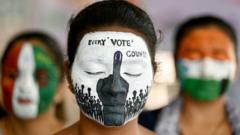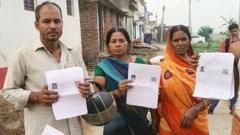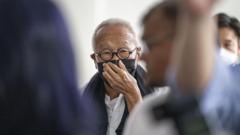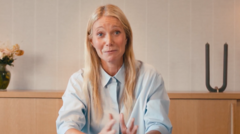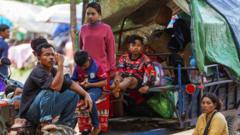In a bid to revitalize its image and attract youth, Singapore's ruling party is harnessing social media and influencers in its campaign strategy ahead of the upcoming election.
**Singapore's Ruling Party Amplifies Digital Strategy to Engage Youth Voters**
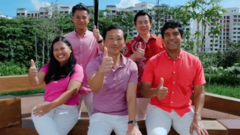
**Singapore's Ruling Party Amplifies Digital Strategy to Engage Youth Voters**
As the general election approaches, Singapore’s People’s Action Party (PAP) is leveraging social media to connect with younger generations.
The TikTok video kicks off with Singapore's Health Minister Ong Ye Kung, cheerfully seated on a park bench, as the familiar theme from the sitcom Friends plays in the background. Soon, he is joined by his election team, showcasing a lively montage filled with fist bumps and community interactions, punctuated by the message: "I'll be there for you".
This is just one of several social media initiatives from Singapore’s long-standing People's Action Party (PAP) as they gear up for the general election. Established in 1959, the PAP has been synonymous with political stability in Singapore. However, as it continues to secure election victories with significant majorities, its popularity has waned over the past two decades, particularly among younger voters who often gravitate toward opposition parties.
In a shift to modernize its image, PAP ministers—traditionally associated with formal speeches—are now creating engaging content with social media influencers and appearing on podcasts. They’ve even produced a limited-edition version of the viral Labubu doll dressed in their party colors.
Prime Minister Lawrence Wong, leading his first election campaign since taking office, has a robust online presence. His TikTok videos feature him showcasing guitar skills or discussing the national budget while visiting a cat café. Meanwhile, other ministers have explored diverse content formats—from culture minister Edwin Tong’s barista series with a local actor to health minister Ong's experience as a trainee at a radio station.
Local influencers play a pivotal role in this campaign strategy. Their collaborative videos featuring PAP members aim to bridge the generational gap. Valerie Tan Su Min, a political satirist and influencer articulated that such collaborations could sway undecided young voters, underscoring the influence of online content in shaping political opinions.
While the PAP is expected to maintain its longstanding grip on power, having previously enjoyed strong support from older demographics, the looming challenge remains their appeal to youth. In recent elections, the party has recorded its lowest popular vote percentages in years, underlining the urgency of attracting younger constituents who are increasingly concerned about issues like rising living costs and job security.
The competition is stiff, as the opposition parties have also embraced social media with creative trends, using platforms like TikTok to engage young voters. A particularly viral moment in this election cycle features an opposition candidate who turned a disheartening campaign experience into a catchy meme.
Despite the PAP’s resources lending a significant advantage to its digital outreach, analysts recognize the importance of authentic engagement over flashy campaigns. Young voters like speaking coach Rae Fung highlight the value of platforms like podcasts, where politicians' sincerity and depth can shine through, shaping their perceptions more than polished social media content.
Concerns around the skyrocketing costs of living and housing affordability loom large among voters, particularly the youth. The PAP has implemented measures like subsidized housing, but a growing faction of younger voters voices skepticism regarding the government’s efficacy in addressing their challenges.
As debates continue, some believe that exercising their votes for opposition candidates offers a viable means for young people to express their concerns about pressing issues. As experts note, engaging voters on social media tees up critical conversations, but the efficacy of these campaigns will ultimately be determined on election day. The challenge lies in whether the ruling party can convincingly address young Singaporeans’ aspirations and economic anxieties while competing against a diverse political landscape.
This is just one of several social media initiatives from Singapore’s long-standing People's Action Party (PAP) as they gear up for the general election. Established in 1959, the PAP has been synonymous with political stability in Singapore. However, as it continues to secure election victories with significant majorities, its popularity has waned over the past two decades, particularly among younger voters who often gravitate toward opposition parties.
In a shift to modernize its image, PAP ministers—traditionally associated with formal speeches—are now creating engaging content with social media influencers and appearing on podcasts. They’ve even produced a limited-edition version of the viral Labubu doll dressed in their party colors.
Prime Minister Lawrence Wong, leading his first election campaign since taking office, has a robust online presence. His TikTok videos feature him showcasing guitar skills or discussing the national budget while visiting a cat café. Meanwhile, other ministers have explored diverse content formats—from culture minister Edwin Tong’s barista series with a local actor to health minister Ong's experience as a trainee at a radio station.
Local influencers play a pivotal role in this campaign strategy. Their collaborative videos featuring PAP members aim to bridge the generational gap. Valerie Tan Su Min, a political satirist and influencer articulated that such collaborations could sway undecided young voters, underscoring the influence of online content in shaping political opinions.
While the PAP is expected to maintain its longstanding grip on power, having previously enjoyed strong support from older demographics, the looming challenge remains their appeal to youth. In recent elections, the party has recorded its lowest popular vote percentages in years, underlining the urgency of attracting younger constituents who are increasingly concerned about issues like rising living costs and job security.
The competition is stiff, as the opposition parties have also embraced social media with creative trends, using platforms like TikTok to engage young voters. A particularly viral moment in this election cycle features an opposition candidate who turned a disheartening campaign experience into a catchy meme.
Despite the PAP’s resources lending a significant advantage to its digital outreach, analysts recognize the importance of authentic engagement over flashy campaigns. Young voters like speaking coach Rae Fung highlight the value of platforms like podcasts, where politicians' sincerity and depth can shine through, shaping their perceptions more than polished social media content.
Concerns around the skyrocketing costs of living and housing affordability loom large among voters, particularly the youth. The PAP has implemented measures like subsidized housing, but a growing faction of younger voters voices skepticism regarding the government’s efficacy in addressing their challenges.
As debates continue, some believe that exercising their votes for opposition candidates offers a viable means for young people to express their concerns about pressing issues. As experts note, engaging voters on social media tees up critical conversations, but the efficacy of these campaigns will ultimately be determined on election day. The challenge lies in whether the ruling party can convincingly address young Singaporeans’ aspirations and economic anxieties while competing against a diverse political landscape.

